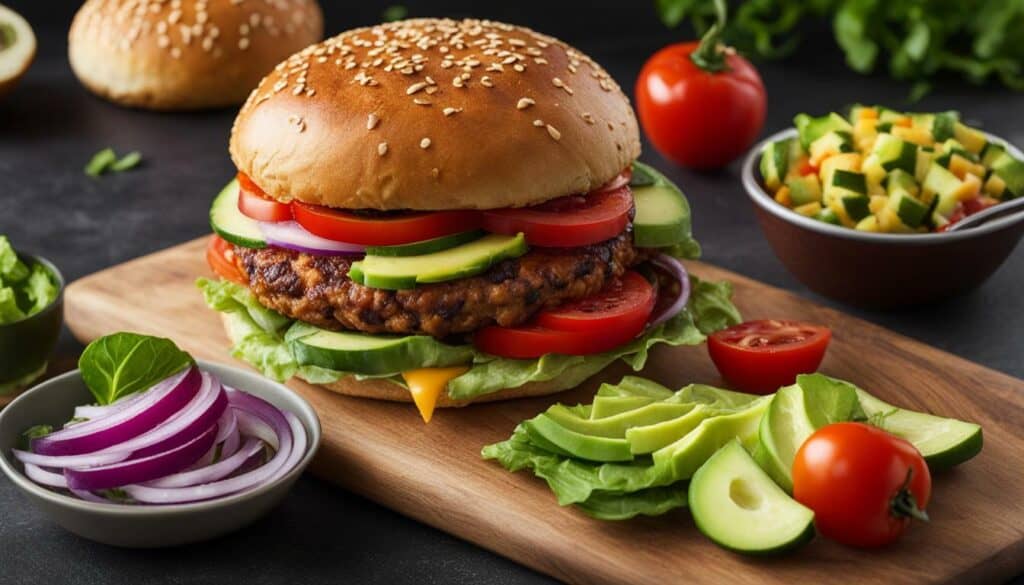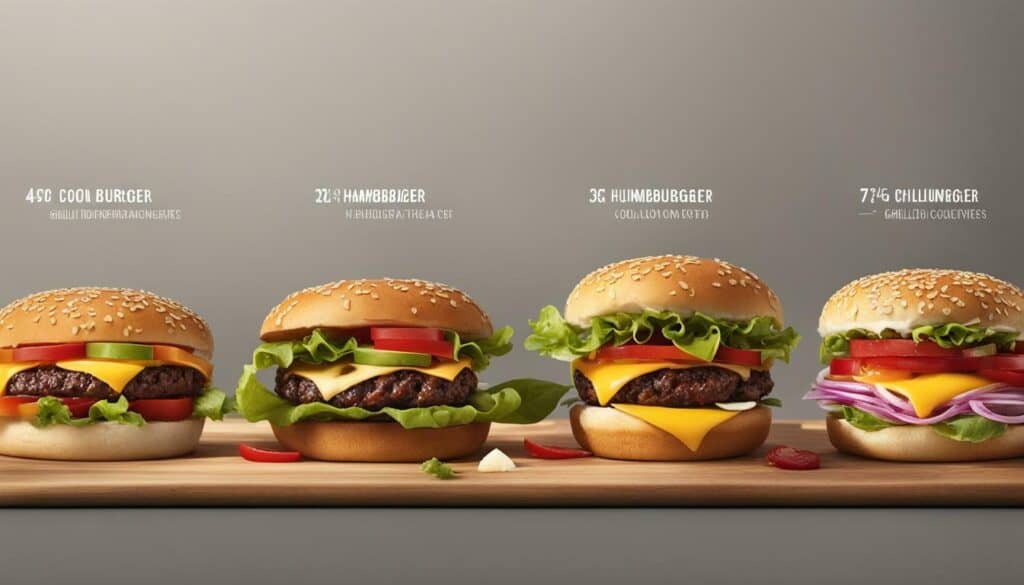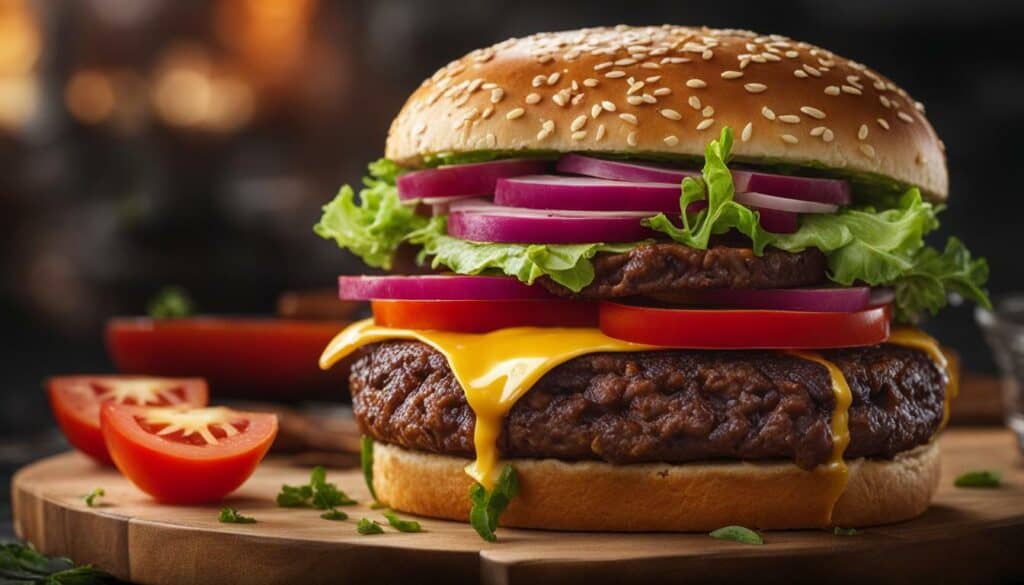Craving a grilled hamburger? Let’s dive into the world of calories and uncover the truth behind your favorite summer delicacy.
In this section, we will explore the truth about the number of calories in grilled hamburgers and uncover some surprising facts. Join me on this journey to indulge guilt-free and make informed choices about your favorite juicy burger.
Key Takeaways:
- Hamburgers and hot dogs are high in calories and saturated fat.
- Lean ground beef or turkey with lower fat percentages is recommended for healthier hamburgers.
- Grass-fed, grass-finished organic lean ground beef can reduce saturated fat content.
- Store-bought burger patties often contain added sodium and preservatives.
- Hot dogs are often high in sodium and saturated fat, choose ones labeled “uncured” or “nitrate-free”.
The Nutritional Value of Grilled Hamburgers
Before we delve into the calorie count, let’s understand the nutritional value of a grilled hamburger and how it contributes to your overall diet. Hamburgers are a popular choice for many, but it is important to make informed choices to ensure a well-balanced meal.
A typical grilled hamburger consists of a patty, a bun, and various toppings and condiments. The nutritional composition of the burger can vary depending on the ingredients used and the portion sizes.
When it comes to calories, the size of the patty and the type of meat used play a significant role. Lean ground beef or turkey with lower fat percentages are recommended for a healthier option. Grass-fed, grass-finished organic lean ground beef can also reduce the saturated fat content. Store-bought burger patties often contain added sodium and preservatives, so it is advisable to check the labels for healthier options.

The nutritional value of a grilled hamburger goes beyond just calories. It can be a good source of protein, but the fat content varies depending on the cut of meat. Fast-food hamburgers are often high in sodium, so be mindful of your intake. Hamburgers are generally low in dietary fiber, but adding vegetables to your burger can help increase your fiber intake. Carbohydrates in hamburgers primarily come from the bun.
Overall, focusing on portion sizes, leaner protein choices, whole-grain buns, and fresh toppings can help boost the nutritional value of your hamburger. By making these mindful choices, you can enjoy a delicious burger while maintaining a balanced diet.
Making Healthier Hamburger Choices
Want to enjoy a delicious hamburger while keeping it healthy? Let’s explore some better options to reduce calories and make your favorite meal guilt-free. When it comes to hamburger options, choosing lean ground beef or turkey is a great place to start. These meats have lower fat percentages compared to regular ground beef, making them a healthier choice for your burger.
To further enhance the nutritional value of your hamburger, consider opting for grass-fed, grass-finished organic lean ground beef. This type of meat is not only leaner but also lower in saturated fat, which can contribute to heart disease when consumed in excess. By making this simple switch, you can enjoy a flavorful burger while reducing your intake of unhealthy fats.
While store-bought burger patties provide convenience, they often contain added sodium and preservatives. To make your burger even healthier, try making your own homemade patties using lean cuts of meat. This way, you have control over the ingredients and can avoid excess sodium and preservatives.
| Burger Options | Benefits |
|---|---|
| Lean ground beef or turkey | Lower in fat compared to regular ground beef |
| Grass-fed, grass-finished organic lean ground beef | Reduced saturated fat content |
| Homemade patties | Avoid added sodium and preservatives |
Remember, choosing healthier burger options is just one part of the equation. To further improve the nutritional profile of your hamburger, consider using whole-grain buns and fresh toppings. Whole grains provide additional fiber and nutrients, while fresh toppings such as lettuce, tomatoes, onions, and avocado can boost the overall nutrition of your burger.
By making mindful choices and incorporating these healthier options into your hamburger, you can still enjoy a tasty meal while reducing your calorie intake and promoting a healthier lifestyle.

It’s not just the patty that matters; toppings and condiments play a crucial role in the overall nutritional value of your grilled burger. While they can add flavor and enhance the eating experience, they can also contribute to excess calories, unhealthy fats, and sodium if not chosen wisely. Let’s take a closer look at some popular toppings and condiments and their nutritional information:
| Topping/Condiment | Calories | Total Fat (g) | Sodium (mg) |
|---|---|---|---|
| Cheese (1 slice) | 70 | 6 | 170 |
| Bacon (1 slice) | 45 | 3.5 | 135 |
| Mayonnaise (1 tbsp) | 90 | 10 | 90 |
| Ketchup (1 tbsp) | 20 | 0 | 160 |
| Mustard (1 tbsp) | 5 | 0 | 120 |
As you can see, some toppings, like cheese and bacon, can significantly increase the calorie and fat content of your burger. However, there are healthier alternatives available. Opting for reduced-fat cheese or turkey bacon can help reduce these numbers without sacrificing flavor. Additionally, you can experiment with lighter condiments like mustard or salsa to add a burst of taste without the excess fat or calories.
Don’t forget about the importance of fresh toppings and vegetables. They not only add crunch and freshness to your burger but also bring important nutrients like vitamins, minerals, and dietary fiber to the table. Consider toppings like lettuce, tomato, onions, and pickles to boost the nutritional value of your burger without piling on extra calories.
Quote:
“Choosing the right toppings and condiments can turn a regular burger into a nutritious meal. By making mindful choices and being aware of the nutritional information, you can enjoy a delicious and satisfying burger without compromising your health.” – Nutrition Expert
Remember, moderation is key. While it’s tempting to pile on all your favorite toppings, try to keep portion sizes in check to avoid an excessive calorie intake. A balanced burger with lean protein, whole-grain buns, and a variety of fresh toppings can still be a delicious and nutritious choice. By paying attention to the nutritional information and being mindful of your choices, you can enjoy a guilt-free grilled burger that satisfies your cravings and supports your overall well-being.

The Role of Portion Control
Controlling your portions is key to enjoying a grilled hamburger while maintaining a balanced diet. Let’s explore how you can manage your intake effectively.
When it comes to portion control, it’s important to be mindful of your serving sizes. A standard hamburger patty is typically around 4 ounces, which is about the size of a deck of cards. Pay attention to the size of the buns as well, as larger buns can add significant calories and carbohydrates to your meal.
One approach to portion control is to use smaller plates. By choosing a smaller plate, you create the illusion of a larger portion, which can help satisfy your hunger without overindulging. Additionally, filling your plate with vegetables, such as lettuce, tomatoes, onions, and pickles, can add volume to your meal and increase the overall nutritional value.
| Portion Control Tips | Benefits |
|---|---|
| Use smaller plates and bowls | Tricks the mind into feeling satisfied with a smaller portion |
| Fill half your plate with vegetables | Increases fiber intake and adds essential vitamins and minerals |
| Measure out your condiments | Avoids excessive calorie intake from dressings and sauces |
By being conscious of your portion sizes and making strategic choices, you can enjoy a delicious grilled hamburger while still maintaining a healthy lifestyle. Remember, it’s all about balance and moderation!

Craving a burger but looking for a healthier alternative? Let’s explore some delicious veggie burger recipes and low-calorie options to satisfy your taste buds.
When it comes to veggie burgers, there are endless possibilities to choose from. Whether you prefer homemade or store-bought, these plant-based alternatives offer a lighter and more nutritious option compared to traditional beef patties. Veggie burgers are typically made with ingredients like beans, lentils, mushrooms, or soy-based proteins, which provide a good source of dietary fiber and essential vitamins.
Here are a few mouthwatering veggie burger recipes to try:
- Black Bean Burger: This classic veggie burger is packed with flavor and protein. Mash black beans, onions, garlic, and spices together, then form into patties and grill them to perfection. Serve on a whole-grain bun with fresh lettuce, tomato, and avocado for a satisfying meal.
- Mushroom and Lentil Burger: Combine sautéed mushrooms, cooked lentils, breadcrumbs, and seasonings to create a juicy and hearty burger. Top it off with grilled onions, melted Swiss cheese, and a dollop of tangy mustard for a burst of flavors.
- Quinoa and Vegetable Burger: Mix cooked quinoa, grated zucchini, carrots, and a variety of herbs and spices to form a nutritious patty. This burger is not only packed with protein but also provides a satisfying crunch from the vegetables. Serve on a whole-grain bun with your favorite toppings for a wholesome meal.
Looking for a low-calorie alternative to the traditional burger? Consider using lean ground turkey or chicken instead of beef. These lean meats are lower in saturated fat and can still deliver a juicy and delicious burger experience. Adding herbs, spices, and chopped vegetables to the meat mixture can enhance both the flavor and nutritional value of your homemade patties.

Remember, the key to a healthier burger lies in the choice of ingredients and cooking methods. Opt for whole-grain buns or lettuce wraps for added fiber and nutrients. Load up your burger with fresh toppings like sliced tomatoes, onions, lettuce, and pickles to add crunch and flavor without piling on extra calories. By exploring these healthier burger alternatives, you can enjoy a satisfying meal while nourishing your body.
| Burger Alternative | Calories (per serving) | Total Fat (g) | Saturated Fat (g) | Protein (g) | Fiber (g) |
|---|---|---|---|---|---|
| Traditional Beef Burger | 250 | 18 | 7 | 20 | 1 |
| Veggie Burger (store-bought) | 150 | 5 | 0.5 | 10 | 6 |
| Turkey Burger | 200 | 10 | 2.5 | 22 | 2 |
The Benefits of Grilling
Grilling your hamburgers not only imparts a smoky and delicious flavor but also offers some health benefits. Let’s uncover why grilling is a great choice for your next burger cookout.
When compared to other cooking methods like frying, grilling helps reduce the consumption of excess fat. While the flames lick the surface of the patty, the fat drips down, resulting in a leaner burger. This means you can enjoy your favorite indulgence with fewer calories and less saturated fat.
Another advantage of grilling is that it allows the excess fat in meats to melt away. This means you’ll be left with a moist and juicy burger without the need for adding extra fats or oils. Plus, the high heat of the grill helps seal in the natural flavors and juices, resulting in a mouthwatering experience.
| Benefits of Grilling: | |
|---|---|
| Reduces the consumption of excess fat | |
| Melts away excess fat in meats | |
| Seals in natural flavors and juices |
Additionally, grilling can be a healthier cooking option as it allows you to prepare your burgers without the need for deep frying or using excessive amounts of oil. The high heat kills harmful bacteria, making grilled burgers a safe and hygienic choice.
So fire up your grill, gather your loved ones, and enjoy the mouthwatering experience of grilled hamburgers. Just remember to choose leaner cuts of meat, go easy on the condiments, and load up on fresh toppings to maximize the nutritional value of your meal.

While grilling is a fantastic cooking method, it’s important to be aware of potential health risks and take necessary precautions to minimize them. When meats are cooked at high temperatures, such as grilling, certain compounds can form that may have negative health effects. For example, the formation of heterocyclic amines (HCAs) and polycyclic aromatic hydrocarbons (PAHs) can occur when meat is exposed to high heat or open flames.
HCAs and PAHs have been linked to an increased risk of cancer, particularly colorectal, pancreatic, and prostate cancers. These compounds are formed when the proteins and fats in meat react to high temperatures, creating potentially harmful substances. However, there are steps you can take to reduce your exposure to these compounds while still enjoying grilled hamburgers.
One way to minimize the formation of HCAs and PAHs is by marinating your meat before grilling. Research has shown that marinating meat with ingredients like vinegar, lemon juice, or herbs can significantly reduce the formation of these harmful compounds. Additionally, using leaner cuts of meat and trimming excess fat can help reduce the amount of fat dripping onto the grill and potentially forming harmful smoke.
Tips for Healthier Grilling:
- Choose leaner cuts of meat with lower fat content to reduce fat dripping and smoke formation.
- Trim excess fat from the meat before grilling.
- Marinate meat for at least 30 minutes before grilling to help reduce the formation of harmful compounds.
- Avoid charring or burning meat, as this can increase the formation of HCAs and PAHs.
- Consider using a grill pan or aluminum foil to create a barrier between the meat and the flames.
- Grill vegetables alongside your hamburgers to add extra flavor and nutritional value to your meal.
By following these tips, you can enjoy delicious grilled hamburgers while minimizing your exposure to potentially harmful compounds. Remember, moderation is key, and incorporating a variety of nutritious foods into your diet is essential for overall health and well-being.

| Grilling Precautions | Benefits of Healthier Choices | Portion Control Strategies |
|---|---|---|
| Marinate meat to reduce harmful compound formation | Choose leaner cuts of meat to reduce fat and calorie intake | Use smaller burger patties or share a larger one |
| Avoid charring or burning meat to minimize HCA and PAH formation | Opt for grass-fed, grass-finished organic lean ground beef to reduce saturated fat content | Load up on fresh vegetables as toppings to increase fiber intake |
| Use grill pans or aluminum foil to minimize direct contact between meat and open flames | Explore healthier burger alternatives like veggie burgers for lower calorie and fat options | Choose whole-grain buns for added nutrition |
Conclusion
Burger lovers, we’ve uncovered the truth about grilled hamburger calories, explored healthier alternatives, and discovered ways to boost the nutritional value. Now you can indulge in a delicious burger while keeping an eye on your calorie intake.
When it comes to hamburgers, choosing lean ground beef or turkey can significantly reduce the saturated fat content. For even healthier options, consider opting for grass-fed, grass-finished organic lean ground beef, which can further reduce saturated fat intake. Be cautious of store-bought burger patties that often contain added sodium and preservatives. Look for alternatives labeled “uncured” or “nitrate-free” in the case of hot dogs, as they tend to be lower in sodium and saturated fat. Hot dogs made with leaner meats like turkey or chicken are also healthier choices.
Veggie burgers can be a lower-calorie alternative, but keep in mind that they are often highly processed. Although they may provide some dietary fiber, it’s best to consume them in moderation. When grilling hamburgers, be aware that high temperatures can lead to the formation of potentially harmful compounds. To boost the nutritional value of your burger, focus on portion sizes, leaner protein choices, whole-grain buns, and fresh toppings. Adding vegetables to your hamburger can also increase your fiber intake.
Grilling hamburgers is considered a healthier cooking method compared to frying. It allows excess fat to drip away and enhances the natural flavors. However, remember to practice portion control to manage your calorie, fat, and sodium intake. While the caloric content of a hamburger can vary depending on the ingredients used and the size of the burger, being mindful of portion sizes can help you enjoy your favorite burger guilt-free.
FAQ
Q: How many calories are in a grilled hamburger?
A: The caloric content of a hamburger can vary depending on the ingredients used and the size of the burger.
Q: Are hamburgers high in saturated fat?
A: Hamburgers can be high in saturated fat, especially if made with fatty cuts of meat or topped with rich condiments.
Q: Can I make a healthier hamburger choice?
A: Yes, you can make healthier hamburger choices by opting for lean ground beef or turkey, grass-fed organic meat, and lower-sodium alternatives.
Q: How do toppings and condiments impact the nutritional content of a hamburger?
A: Toppings and condiments can significantly impact the nutritional content of a hamburger. Choosing fresh toppings and lighter condiments can make your burger more nutritious.
Q: Is portion control important when it comes to hamburgers?
A: Yes, portion control is important for managing calorie, fat, and sodium intake. It’s best to enjoy hamburgers in moderation and balance them with other nutritious foods.
Q: Are there healthier alternatives to traditional hamburgers?
A: Yes, there are healthier alternatives to traditional hamburgers, such as veggie burgers and low-calorie recipes. These options can be lower in calories and fat.
Q: Is grilling a healthier cooking method for hamburgers?
A: Grilling is generally considered a healthier cooking method compared to frying because it allows excess fat to drip off the meat. However, it’s important to avoid charring the meat, as high temperatures can lead to the formation of potentially harmful compounds.
Q: Are there any potential health concerns related to grilling hamburgers?
A: Grilling hamburgers at high temperatures can lead to the formation of potentially harmful compounds. To minimize these risks, avoid charring the meat and consider using leaner cuts or alternative options like veggie burgers.
What Are the Calorie Counts of Chicken 65 Compared to Grilled Hamburgers?
When comparing the calorie counts of chicken 65 and grilled hamburgers, it is essential to analyze the chicken 65 calorie breakdown. Chicken 65 typically contains around 200-250 calories per serving, while grilled hamburgers can range from 250-300 calories. These figures may fluctuate depending on the ingredients used and the cooking methods employed.





Leave a Reply